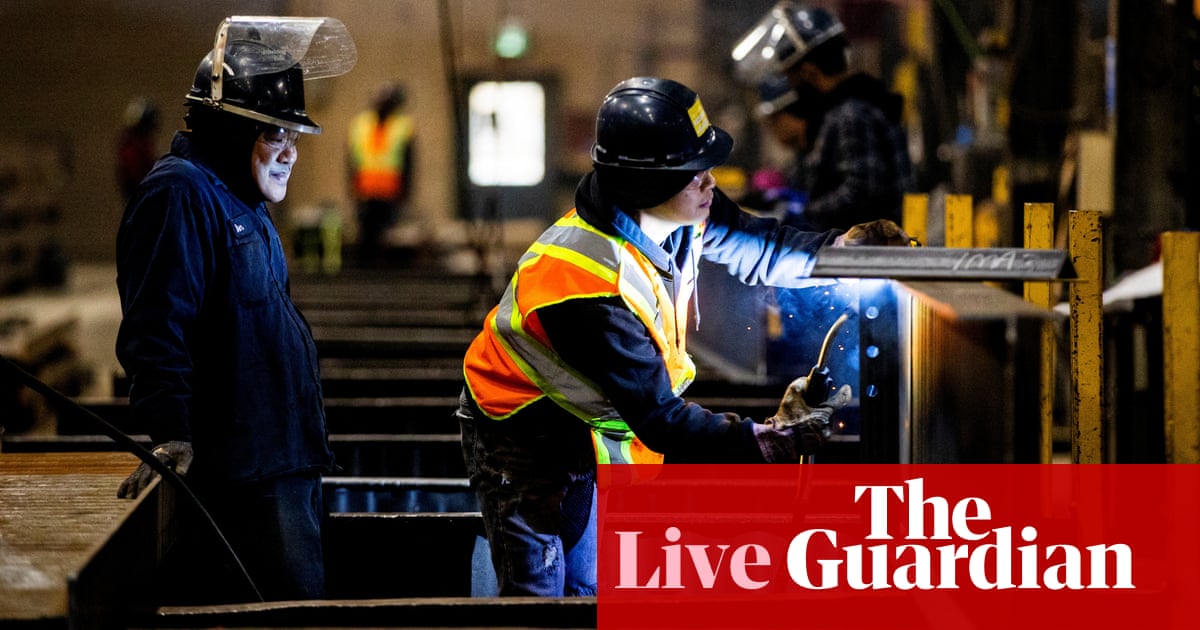Gold hits $2,900 per ounce – next stop $3,000?
The gold price is continuing to hit new peaks this morning, as trade war fears fuel a dash for safe assets.
Gold has now hit a new all-time high of $2,900 per ounce, extending its earlier gains – and leading to speculation that it could soon hit the $3k level.
ING’s commodity strategist, Ewa Manthey, suggests the $3,000 level is now in sight, as concerns that tariffs will lead to higher inflation and slower economic growth are spurring demand for safe haven assets.
Manthey wrote last week:
US President Donald Trump’s latest comments suggesting that the US takes over the Gaza strip and assumes responsibility for reconstructing the territory have added to this uncertainty, further boosting gold prices.
With Trump back in the White House, uncertainty and unpredictability are running high. And gold will continue to benefit from this environment.
Key events
MPs demand answers about Bank IT shambles
After a series of banking IT failures which have disrupted services for customers over the last couple of years, MPs are demanding answers.
Parliament’s Treasury Committee have wrtten to the bosses of the nine largest UK banks and building societies, asking how much disruption their customers have suffered over the last two years.
They also want to know how many customers were affected, and the amount of compensation that has been paid.
The letter comes after Barclays suffered an IT glitch that lasted for several days, during which time some customers saw outdated balances, or could not see their latest payment.
Chair of the Treasury Select Committee, Dame Meg Hillier MP, says:
“When a bank’s IT system goes down, it can be a real problem for our constituents who were relying on accessing certain services so they can buy food or pay bills.
For it to happen at a major bank such as Barclays at such a crucial time of year is either bad luck or bad planning. Either way, it’s important to learn what has happened and what will be done about it.
The rapidly declining number of high street bank branches makes the impact of IT outages even more painful; that’s why I’ve decided to write to some of our biggest banks and building societies.”
As tariffs are inflationary, they may make it harder for the US central bank to lower interest rates this year.
Currently the financial markets expect just one rate cut from the Federal Reserve during 2025, currently expected by July.
Enrique Diaz-Alvarez, chief economist at global financial services firm Ebury, reckons the relative strength of the US economy will also make cuts to borrowing costs harder to justify.
“Trying to predict the next tariff update to hit the newswires is a bit of a fool’s errand, so it is perhaps more productive to focus more on the macroeconomic backdrop.
“Last week’s nonfarm payrolls report was, once again, consistent with a US labour market that remains strong. Companies continue to create jobs at a healthy clip, the unemployment rate is hovering around levels consistent with full employment, and the report showed a surprise uptick in wages in January – monthly earnings rose at their fastest pace since mid-2023.
“All of this positive economic news, plus the looming threat of price hikes from Trump’s tariffs, makes it increasingly difficult to justify any further interest rate cuts at all from the Fed in 2025.
“With rates in the US remaining almost the highest in the G10, we think that it will be difficult for the dollar to sell-off in spite of its admittedly very expensive levels.”
BP shares hit six-month high after Elliott builds stake
Shares in oil giant BP have hit a six-month high after activist investor Elliott Management took a stake in the company.
Traders are calculating that Elliott will push for an overhaul of BP’s strategy, and a shake-up of its board which could claim chairman Helge Lund.
BP’s shares are up 6.35% at 460.70p, the highest since last August, after Elliott’s stake was reported on Saturday.
BP shareholders may be impatient for improvement, as Richard Hunter, head of markets at interactive investor, says:
The shares have drifted by around 3% over the last year, in contrast to a gain of some 6% for rival Shell over that period and it remains to be seen whether this latest speculation will provide a shot in the arm for what has been a relatively disappointing period for the group of late
BP is due to release its latest financial results tomorrow, after recently setting out plans to cut thousands of jobs from its global workforce to save billions in costs and appease its worried shareholders.
BP has fallen out of favour with many investors since embarking on a plan to slash its oil and gas production in favour of spending billions on renewable energy projects…
More here:
Goldman: US immigration clampdown could hurt growth
Another one of Donald Trump’s policies, a crackdown on illegal immigration, could also hurt the US economy.
A new note from Goldman Sachs today predicts that net immigration into the US will slow to 750k per year, as the Trump administration increases border security, reinstates the “Remain in Mexico” programme, and ends several humanitarian parole programmes.
That would be a drop from an annualised rate of 1.7 million/year last December, Goldman say.
In that “baseline scenario”, lower immigration would lead to up to 40 basis points less growth per year – the equivalent of 0.1% off GDP each quarter.
But, Goldman warns, the economic consequences would be more serious in a scenario where Trump’s immigration crackdown creates a climate in which unauthorized immigrants are afraid to go to work or employers are afraid to employ them.
That’s because unauthorized immigrants already in the US account for 4-5% of the total workforce and 15-20% in some industries, Goldman says, adding:
Abruptly losing these workers could be very disruptive for many of these industries and have a larger inflation impact.
Wall Street futures higher
The US stock market is set to open higher, despite anxiety about more tariffs heading our way.
The Dow Jones industrial average, of 30 large US companies, is 0.27% higher in the futures market.
The broader S&P 500 index is expected to gain 0.33% when Wall Street opens in four and a half hours.
The tech-focused Nasdaq is 0.5% higher in pre-market.
This chart from XM shows how gold has been outperforming other assets this morning:
Achilleas Georgolopoulos, senior market analyst at XM, says:
Gold has recorded a higher high, trading at $2,897 at the time of writing… fueled by tariff concerns and US data pointing to higher inflation going forward.
On the flip side, oil faces a mixed outlook at this stage. A full-blown trade war between the US, EU and China would unquestionably damage global growth rates, thus reducing the already subdued demand for oil. However, should Trump harden his stance on tariffs, and the Ukraine-Russia conflict ends by Easter, as Trump aims for, then bearish pressure could intensify.
Investors need to understand why Donald Trump keeps threatening, and imposing, tariffs, says Morgan Stanley’s Michael Zezas.
Zezas tells clients:
Simply put, tariffs are bargaining chips, not a policy goal. The current administration is using them to achieve the objectives of its “America First Trade Policy”: to reduce the trade deficit in goods, and to protect national security and global economic advantage by nurturing key technologies and securing sensitive supply chains.
Voters and elected officials may debate whether tariffs are the right tool, and some may even argue that these aren’t the right goals. But opinion surveys and bipartisan policy actions suggest that support for these objectives is indeed the consensus and has been for some time.
Hence, it’s not surprising that the Trump administration is actively exploring, developing, and deploying tariff authorities across a range of geographies and products to achieve these ends.
Here’s the moment tariff fears pushed gold up to a new round-number high:
Gold hits $2,900 per ounce – next stop $3,000?
The gold price is continuing to hit new peaks this morning, as trade war fears fuel a dash for safe assets.
Gold has now hit a new all-time high of $2,900 per ounce, extending its earlier gains – and leading to speculation that it could soon hit the $3k level.
ING’s commodity strategist, Ewa Manthey, suggests the $3,000 level is now in sight, as concerns that tariffs will lead to higher inflation and slower economic growth are spurring demand for safe haven assets.
Manthey wrote last week:
US President Donald Trump’s latest comments suggesting that the US takes over the Gaza strip and assumes responsibility for reconstructing the territory have added to this uncertainty, further boosting gold prices.
With Trump back in the White House, uncertainty and unpredictability are running high. And gold will continue to benefit from this environment.
The US dollar index, which tracks the greenback against a basket of currencies, has risen by 0.23% today.
It’s hit a record high against India’s rupee, for example, which fell to almost 88 rupee to the dollar.
The pound is a little weaker against the dollar too, at $1.2395.
In the markets, it’s turning into “a febrile February”
Markets are at the mercy of what is turning into “a febrile February”, says. Richard Hunter, head of markets at interactive investor.
Another raft of announcements are keeping volatility high on the agenda, Hunter explains:
Tariffs remain central to the uncertainty, with President Trump’s latest announcement on Sunday likely to keep investors on edge this week. He has threatened reciprocal tariffs across the board to equal the rates being charged to the US, quite apart from a 25% levy on the import of steel and aluminium.
Sentiment was already wavering at the end of the week with a survey which showed that consumer sentiment had fallen to 67.8 in February against estimates of 71.3 and perhaps even more concerningly that inflation expectations had risen to 4.3%. The jump in the anticipated rate of inflation was a potential canary in the coal mine in quantifying the effects of tariffs, while also vindicates the decision of the Federal Reserve to hold fire on interest rate cuts for the time being.
Australia’s stock market lost ground today as investors reacted to Donald Trump’s plan to bring in new tariffs on steel and aluminium.
The S&P/ASX index of Australia’s largest companies dipped by 0.3%, pulled down by mining companies such as BHP Group (-1%) and Rio Tinto (-1.2%).
They fell as the iron ore price was hit by Trump’s announcement – although the iron ore price has since recovered…..
UK must ‘wait and see’ if Trump provides clarity on steel tariff threat
Home Office minister Dame Angela Eagle said the UK will have to “wait and see” if Donald Trump provides more clarity on his threat to impose tariffs on all steel and aluminium imports to the US.
Speaking this morning, Eagle said the UK government must “wait and see whether the president gets more specific about what he meant by that comment”, PA Media reports.
Eagle added:
“We have a very balanced trading relationship with the US – I think £300 billion worth of trade between our countries – and I think it’s in the best interests of both of us, as longstanding allies and neighbours, that we carry on with that balanced trade.”












